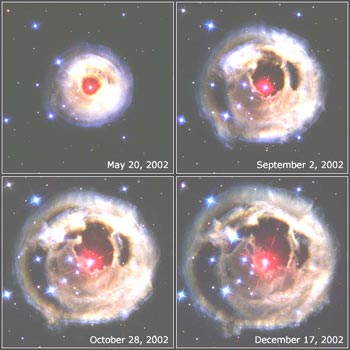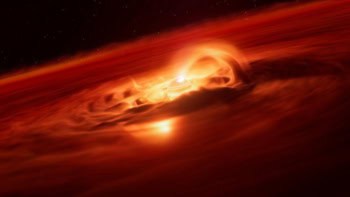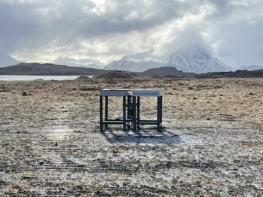When a star in the constellation of Monoceros, or the “Unicorn”, erupted in January last year, it temporarily became the brightest star in the Milky Way. Howard Bond of the Space Telescope Science Institute in Maryland and astronomers in the US, the Canary Islands and Italy have now used the Hubble Space Telescope to study the light emitted by the star, known as V838 Monocerotis. Their work is significant in that it provides a new method for measuring how far away stars are (H E Bond et al. 2003 Nature 422 405).

Novae and supernovae usually undergo explosive outbursts that eject stellar material into space. When V838 Mon erupted, it brightened by a factor of 10 000 and so led astronomers to believe that it was a classical nova. However, the star did not eject its outer layers and expose a hot core – unlike a conventional nova – but simply expanded to become a cool, luminous supergiant instead. This transformation defies the conventional understanding of the life cycle of stars.
Bond and co-workers found that the star underwent rapid and complex changes in brightness between January and April 2002. Hubble Space Telescope images show “light echoes”, which are a series of nearly circular arcs and rings, centred on the star (see figure). These echoes are created by light propagating into the surrounding stellar dust.
Using these measurements, the researchers calculated that the star is about 20 000 light years away. It appears to be a new type of outburst in which the star expands rapidly to supergiant dimensions in a hitherto unseen mechanism.
“At this point, we can only say that we know of two sources that could release so much energy so quickly: gravitational energy, or thermonuclear energy,” Bond told Physics Web. “Gravitational energy, such as in a stellar collision or merger, seems unlikely because the surrounding circumstellar dust suggests that V838 Mon has undergone previous outbursts – a stellar interaction would be a one-time event. We may be seeing the release of energy through nuclear fusion, but in a region of parameter space that we have not seen before.”
The team now hopes to continue with the Hubble Telescope observations and create a three-dimensional map of the circumstellar dust. It also wants to refine the distance calculations and determine the exact nature of the underlying stellar system.



